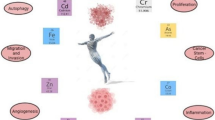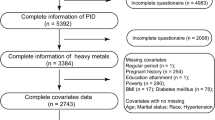Abstract
There have been increasing concerns regarding health problems due to endocrine disrupting chemicals (EDCs). We investigated association of heavy metals, including lead, mercury, and cadmium, with metabolic syndrome (MS) and its individual components in the Korean population. Participants included 1,961 males and 1,989 females 20 years of age or older from the fourth and fifth Korea National Health and Nutritional Examination Surveys of the Korean population (2009 and 2010). We examined the relationship of blood lead, mercury, and cadmium levels with MS and the additive effect of three heavy metals on MS after adjustment for age, sex, body mass index (BMI), region, smoking, alcohol consumption, and regular exercise. Blood concentration of lead showed a significant but modest association with prevalence of MS (P = 0.04). Other heavy metals did not show such a relationship with MS. When the participants were classified according to the sum of category numbers of the three heavy metals, adjusted odds ratios were 1.0, 1.355, 1.638, and 1.556 (P < 0.01). Among components of MS, significant relationship of the sum of heavy metals with hypertension and elevated triglyceride was demonstrated. Blood concentration of lead was positively associated with the prevalence of MS. Of particular interest, cumulative effect of a mixture of lead, mercury, and cadmium on prevalence of MS was stronger than the sum of effect of each heavy metal. Accumulative effect of exposure to heavy metals could be more additive or synergistic than individual exposure in the general population.
Similar content being viewed by others
References
E. Diamanti-Kandarakis, J.P. Bourguignon, L.C. Giudice, R. Hauser, G.S. Prins et al., Endocrine-disrupting chemicals: an Endocrine Society scientific statement. Endocr. Rev. 30, 293–342 (2009)
T.T. Schug, A. Janesick, B. Blumberg, J.J. Heindel, Endocrine disrupting chemicals and disease susceptibility. J. Steroid Biochem. Mol. Biol. 127, 204–215 (2011)
M.C. Henson, P.J. Chedrese, Endocrine disruption by cadmium, a common environmental toxicant with paradoxical effects on reproduction. Exp. Biol. Med. (Maywood) 229, 383–392 (2004)
A. Rosin, The long-term consequences of exposure to lead. Isr. Med. Assoc. J. 11, 689–694 (2009)
S. Satarug, M.R. Moore, Adverse health effects of chronic exposure to low-level cadmium in foodstuffs and cigarette smoke. Environ. Health Perspect. 112, 1099–1103 (2004)
B.K. Lee, The role of biological monitoring in the health management of lead-exposed workers. Toxicol. Lett. 108, 149–160 (1999)
M. Mercier, International approach of the assessment of chemical risks. J. Hyg. Epidemiol. Microbiol. Immunol. 34, 1–7 (1990)
K. Jomova, M. Valko, Advances in metal-induced oxidative stress and human disease. Toxicology 283, 65–87 (2011)
M.C. Houston, The role of mercury and cadmium heavy metals in vascular disease, hypertension, coronary heart disease, and myocardial infarction. Altern. Ther. Health Med. 13, S128–S133 (2007)
A. Navas-Acien, E. Guallar, E.K. Silbergeld, S.J. Rothenberg, Lead exposure and cardiovascular disease—a systematic review. Environ. Health Perspect. 115, 472–482 (2007)
J.L. Peters, L.D. Kubzansky, A. Ikeda, S.C. Fang, D. Sparrow et al., Lead concentrations in relation to multiple biomarkers of cardiovascular disease: the Normative Aging Study. Environ. Health Perspect. 120, 361–366 (2012)
C.H. You, B.G. Kim, J.M. Kim, S.D. Yu, Y.M. Kim et al., Relationship between blood mercury concentration and waist-to-hip ratio in elderly Korean individuals living in coastal areas. J. Prev. Med. Public Health 44, 218–225 (2011)
F. Scinicariello, H.G. Abadin, H.E. Murray, Association of low-level blood lead and blood pressure in NHANES 1999–2006. Environ. Res. 111, 1249–1257 (2011)
I. Mordukhovich, R.O. Wright, H. Hu, C. Amarasiriwardena, A. Baccarelli et al., Associations of toenail arsenic, cadmium, mercury, manganese, and lead with blood pressure in the Normative Aging Study. Environ. Health Perspect. 120, 98–104 (2012)
B.O. Lund, D.M. Miller, J.S. Woods, Studies on Hg(II)-induced H2O2 formation and oxidative stress in vivo and in vitro in rat kidney mitochondria. Biochem. Pharmacol. 45, 2017–2024 (1993)
B.J. Shenker, T.L. Guo, I.M. Shapiro, Low-level methylmercury exposure causes human T-cells to undergo apoptosis: evidence of mitochondrial dysfunction. Environ. Res. 77, 149–159 (1998)
M.C. Houston, Role of mercury toxicity in hypertension, cardiovascular disease, and stroke. J. Clin. Hypertens. (Greenwich) 13, 621–627 (2011)
Y.W. Chen, C.Y. Yang, C.F. Huang, D.Z. Hung, Y.M. Leung et al., Heavy metals, islet function and diabetes development. Islets 1, 169–176 (2009)
S.S. Moon, Association of lead, mercury and cadmium with diabetes in the Korean population: the Korea National Health and Nutrition Examination Survey (KNHANES) 2009–2010. Diabet. Med. 30, e143–e148 (2013)
D.H. Lee, M.W. Steffes, D.R. Jacobs Jr., Can persistent organic pollutants explain the association between serum gamma-glutamyltransferase and type 2 diabetes? Diabetologia 51, 402–407 (2008)
D.H. Lee, D.R. Jacobs Jr., Association between serum concentrations of persistent organic pollutants and gamma glutamyltransferase: results from the National Health and Examination Survey 1999–2002. Clin. Chem. 52, 1825–1827 (2006)
M.A. Cornier, D. Dabelea, T.L. Hernandez, R.C. Lindstrom, A.J. Steig et al., The metabolic syndrome. Endocr. Rev. 29, 777–822 (2008)
Y.S. Yoon, S.W. Oh, H.W. Baik, H.S. Park, W.Y. Kim, Alcohol consumption and the metabolic syndrome in Korean adults: the 1998 Korean National Health and Nutrition Examination Survey. Am. J. Clin. Nutr. 80, 217–224 (2004)
H.S. Choi, H.J. Oh, H. Choi, W.H. Choi, J.G. Kim et al., Vitamin D insufficiency in Korea—a greater threat to younger generation: the Korea National Health and Nutrition Examination Survey (KNHANES) 2008. J. Clin. Endocrinol. Metab. 96, 643–651 (2011)
Y. Kim, B.K. Lee, Associations of blood lead, cadmium, and mercury with estimated glomerular filtration rate in the Korean general population: analysis of 2008–2010 Korean National Health and Nutrition Examination Survey data. Environ. Res. 118, 124–129 (2012)
N.S. Kim, B.K. Lee, National estimates of blood lead, cadmium, and mercury levels in the Korean general adult population. Int. Arch. Occup. Environ. Health 84, 53–63 (2011)
S.M. Grundy, J.I. Cleeman, S.R. Daniels, K.A. Donato, R.H. Eckel et al., Diagnosis and management of the metabolic syndrome: an American Heart Association/National Heart, Lung, and Blood Institute Scientific Statement. Circulation 112, 2735–2752 (2005)
S.Y. Lee, H.S. Park, D.J. Kim, J.H. Han, S.M. Kim et al., Appropriate waist circumference cutoff points for central obesity in Korean adults. Diabetes Res. Clin. Pract. 75, 72–80 (2007)
D.H. Lee, I.K. Lee, K. Song, M. Steffes, W. Toscano et al., A strong dose-response relation between serum concentrations of persistent organic pollutants and diabetes: results from the National Health and Examination Survey 1999–2002. Diabetes Care 29, 1638–1644 (2006)
A. Whaley-Connell, P.A. McCullough, J.R. Sowers, The role of oxidative stress in the metabolic syndrome. Rev. Cardiovasc. Med. 12, 21–29 (2011)
A. Bhatnagar, Environmental cardiology: studying mechanistic links between pollution and heart disease. Circ. Res. 99, 692–705 (2006)
M.G. Weisskopf, N. Jain, H. Nie, D. Sparrow, P. Vokonas et al., A prospective study of bone lead concentration and death from all causes, cardiovascular diseases, and cancer in the Department of Veterans Affairs Normative Aging Study. Circulation 120, 1056–1064 (2009)
O. Ademuyiwa, R.N. Ugbaja, F. Idumebor, O. Adebawo, Plasma lipid profiles and risk of cardiovascular disease in occupational lead exposure in Abeokuta, Nigeria. Lipids Health Dis. 4, 19 (2005)
P.L. Cocco, E. Cocco, M.S. Anni, C. Flore, A. Melis et al., Occupational exposure to lead and blood cholesterol in glucose-6-phosphate dehydrogenase deficient and normal subjects. Res. Commun. Chem. Pathol. Pharmacol. 72, 81–95 (1991)
M.A. Serdar, F. Bakir, A. Hasimi, T. Celik, O. Akin et al., Trace and toxic element patterns in nonsmoker patients with noninsulin-dependent diabetes mellitus, impaired glucose tolerance, and fasting glucose. Int. J. Diabetes Dev. Ctries. 29, 35–40 (2009)
H.I. Afridi, T.G. Kazi, N. Kazi, M.K. Jamali, M.B. Arain et al., Evaluation of status of toxic metals in biological samples of diabetes mellitus patients. Diabetes Res. Clin. Pract. 80, 280–288 (2008)
J.L. Leasure, A. Giddabasappa, S. Chaney, J.E. Johnson Jr., K. Pothakos et al., Low-level human equivalent gestational lead exposure produces sex-specific motor and coordination abnormalities and late-onset obesity in year-old mice. Environ. Health Perspect. 116, 355–361 (2008)
E. Brodkin, R. Copes, A. Mattman, J. Kennedy, R. Kling et al., Lead and mercury exposures: interpretation and action. CMAJ 176, 59–63 (2007)
J.W. Chang, H.L. Chen, H.J. Su, P.C. Liao, H.R. Guo et al., Simultaneous exposure of non-diabetics to high levels of dioxins and mercury increases their risk of insulin resistance. J. Hazard Mater. 185, 749–755 (2011)
W. Swaddiwudhipong, P. Limpatanachote, P. Mahasakpan, S. Krintratun, B. Punta et al., Progress in cadmium-related health effects in persons with high environmental exposure in northwestern Thailand: a five-year follow-up. Environ. Res. 112, 194–198 (2012)
R.R. Bell, J.L. Early, V.K. Nonavinakere, Z. Mallory, Effect of cadmium on blood glucose level in the rat. Toxicol. Lett. 54, 199–205 (1990)
B.K. Lee, Y. Kim, Blood cadmium, mercury, and lead and metabolic syndrome in South Korea: 2005–2010 Korean National Health and Nutrition Examination Survey. Am. J. Ind. Med. (2012). doi:10.1002/ajim.22107
Acknowledgments
This research was supported by a grant from the Daegu and Kyungpook local committee of the Korean Diabetes Association and by the Dongguk University research fund.
Conflict of interest
There are no conflicts of interest.
Disclosure
The author has nothing to declare.
Author information
Authors and Affiliations
Corresponding author
Electronic supplementary material
Below is the link to the electronic supplementary material.
Rights and permissions
About this article
Cite this article
Moon, SS. Additive effect of heavy metals on metabolic syndrome in the Korean population: the Korea National Health and Nutrition Examination Survey (KNHANES) 2009–2010. Endocrine 46, 263–271 (2014). https://doi.org/10.1007/s12020-013-0061-5
Received:
Accepted:
Published:
Issue Date:
DOI: https://doi.org/10.1007/s12020-013-0061-5




